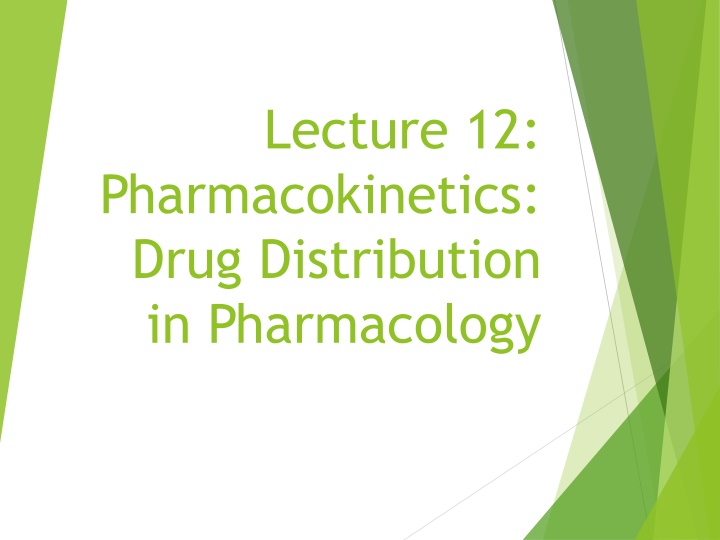
Drug Distribution in Pharmacology: Mathematical Modeling of Drug Effects
Explore the mathematical modeling of drug effects in pharmacology, focusing on drug distribution in a two-compartment system. Learn about drug uptake by tissues, equilibrium between compartments, rates of penetration, decomposition in the blood, and more.
Download Presentation

Please find below an Image/Link to download the presentation.
The content on the website is provided AS IS for your information and personal use only. It may not be sold, licensed, or shared on other websites without obtaining consent from the author. If you encounter any issues during the download, it is possible that the publisher has removed the file from their server.
You are allowed to download the files provided on this website for personal or commercial use, subject to the condition that they are used lawfully. All files are the property of their respective owners.
The content on the website is provided AS IS for your information and personal use only. It may not be sold, licensed, or shared on other websites without obtaining consent from the author.
E N D
Presentation Transcript
Lecture 12: Pharmacokinetics: Drug Distribution in Pharmacology
Mathematical Modeling of Drug Effects - a More General Approach We consider the case when a drug is injected intravenously at a constant rate and the drug is taken up by one particular tissue on which it exerts its bio- chemical reaction. A two-compartment (blood and tissue) system will now be considered with the parameters for the blood compartment being: the total amount of the drug in the blood xg; the volume of blood v1and the concentration of the drug in the blood c1, while those of the tissue compartment are: the total amount of the drug in the tissue w; the volume of the tissue v2and the concentration of the drug in the tissue c2. Finally the rate of injection is denoted by Vgs-1 We also have that x = c1v1 c1 = (x/v1) (16) w = c2v2 c2= (x/v2) (17)
Mathematical Modeling of Drug Effects - a More General Approach The rate of penetration of a drug per cm2per second from one into the other tissue will be h(c1 kc2) .(18) where h is the permeability of the membrane which separates the blood from the tissue, and k is a constant known as the partition coefficient for the drug between blood and tissue. If c1= kc2the two compartments will be in equilibrium and no flow through the membrane will take place. If S denotes the total area of membrane then the total flow from blood to tissue per second will be Sh(c1 kc2) ..(19)
Mathematical Modeling of Drug Effects - a More General Approach This will be the rate of loss of the drug from the blood to the tissue. Moreover, normally when a drug is taken it undergoes a decomposition in the blood. We consider for our modelling purpose that the drug decomposes at a rate proportional to its own concentration c1. Thus we may write the rate of decomposition as k1c1 ..(20) where k1is a constant of proportionality. Hence the rate of disappearance of the drug from the blood due to decomposition is thus, the total rate of disappearance of the drug from the blood is Sh(c1 kc2) + k1c1v1 (21)
Mathematical Modeling of Drug Effects - a More General Approach But the total rate of change (dx/dt) of the amount of the drug in the blood is equal to the rate of injection V less the total rate of disappearance. Hence (dx)/(dt) = V [Sh (c1 kc2) + k1c1v1] ..(22) or, using equations (16) & (17), (dx)/(dt) = V [Sh ((x/v1) k(w/v2)) + k1c1v1] .. (23) We will now introduce two more parameters, namely and (say), where =kv1/v2, =Sh/v1 With the aid of and equation (23) simplifies to dx/dt= V - (x w) k1x .(24)
Mathematical Modeling of Drug Effects - a More General Approach The amount of drug entering the tissue is equal ie the amount leaving the blood, since we considered the case where only one tissue takes up the drug. This amount is given by (21), which simplifies to Sh(c1 kc2) = Sh/v1(c1 kc2v2) = (x w) ..(25) Furthermore, in the tissue the drug is also used up and therefore is gradually destroyed. Similarly to the above analysis we now assume that the rate of destruction of the drug is proportional to the concentration c2in the tissue. Thus we may write the rate of destruction in the tissue using the same constant of proportionality k1as K1c2
Mathematical Modeling of Drug Effects - a More General Approach For the whole tissue, the rate of destruction is k1c2v2gs-1 which is equal to k1w (from equation (17)). Hence the total rate of change (dw/dt) of the amount of the drug in the tissue is dw/dt= (x w) k1w ..(26) The system of differential equations given by equations (24) and (26) can be readily solved by standard methods.
Problems 1. Suppose the concentration of a drug in the blood stream obeys the law (dc)/(dt) = - kc2 and equal doses of the drug are given at time 0, T, 2T, 3T, 4T,... c_{n} is the amount of the drug in the blood immediately after the nth dose, show that the sequence \{c_{n}\} is monotonically increasing. What a sn oo? Find the average amount of the drug in the system in the time interval (0, nT) , and find the limit of the average amount as n -> .
Problems 2. Discuss the general case for the above problem given by (dc)/(dt) =-kc2r where n is a positive integer. C limn {C0[1 + exp(-kt) + +exp(- (n-1)kt)} =C0 / (1 exp(-kt))
